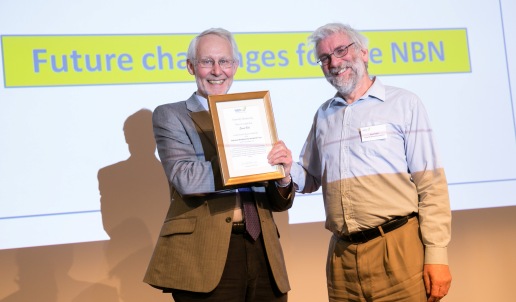The NBN Trust awards honorary membership to individuals who have made an outstanding personal contribution towards the objectives of the Trust. The award is usually given during the proceedings of the NBN Conference and it was no different this year, as the award was presented to Stuart Ball.
The following text was provided by Paul Harding MBE
Stuart has an almost unique combination of quantitative skills, programming expertise and deep understanding of natural history. These have been fundamental to supporting and developing biological recording for 25 years, contributing significantly to the success of the NBN.

Stuart's pioneering work in developing and maintaining a data management system specifically designed for biological recording began as early as 1984 when, at a BCG conference, he demonstrated a package he was developing for his own recording. This was taken-up in the margins of the NFBR conference at Bristol in 1987 – prompted by Bill Ely (an active recorder who also ran a Local Environmental Records Centre in Rotherham), to develop a standard package, especially for amateur recorders and LERCs. This grew into the Recorder project – which, despite its many faults and many versions, has served as a model for biological recording data management systems for more than 20 years, with Stuart's active involvement throughout the first decade and a half.
Recorder 2000 started development in 1999, went out in 2000, and Stuart was closely involved with design of 2000, 2002 and Recorder 6. As Recorder 6 was developed professionally he became less involved. Recorder resellers depended on Stuart for some years because he wrote the software to transfer data from Recorder 3 to Recorder 2000/2 and Recorder 6, and provided a lot of support for those using it.
Stuart has contributed to Diptera recording in general, but in particular, since 1990, has run the Hoverfly Recording Scheme (jointly with Roger Morris). This has proved to be a model for how a scheme for a moderately difficult group could be made popular and effective by communicating with recorders and providing training at all levels, from beginners to improving experts. Their provisional atlas (2000) was an excellent example of what can be done with data from a recording scheme, and data from the scheme is available on the NBN Gateway. The atlas was updated in 2011 and this further broadened the evidence of what can be done with such data.
Lastly, his developmental work on the analysis and interpretation of recording scheme data has been highly influential in stimulating wider use of biological recording data for measuring trends, both by raising awareness of the possibilities to the wider recording community but also by spurring the interest of statisticians. He led the way by developing and applying techniques to analyse the Hoverfly Recording Scheme data in novel ways to understand the impacts of climate change, habitat loss and their interactions.
You can see who the other Honorary Members are here.
We are sad to report on the passing of one of our honorary members, Bob George who passed away on 9th November.
